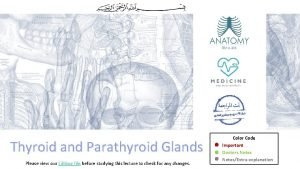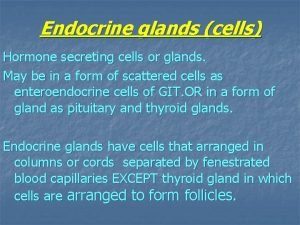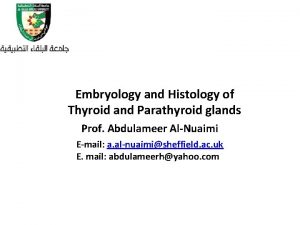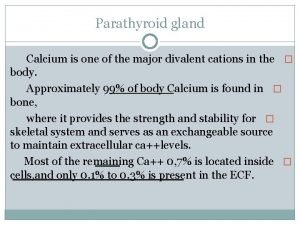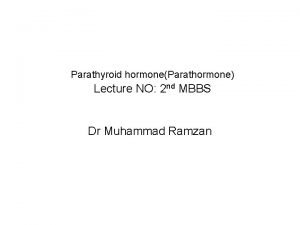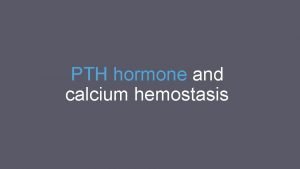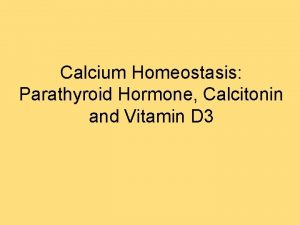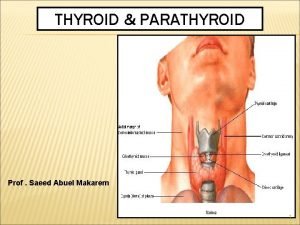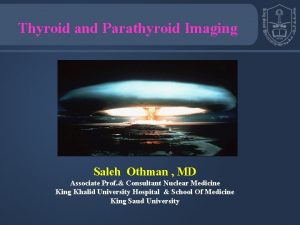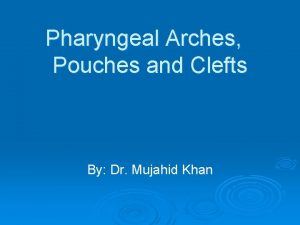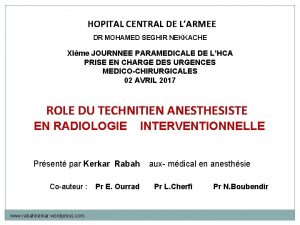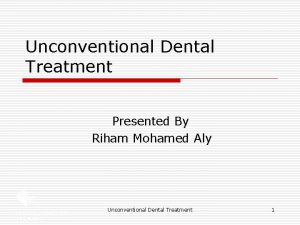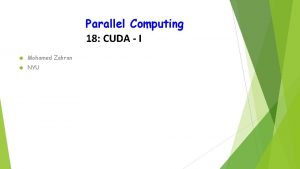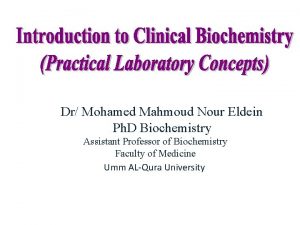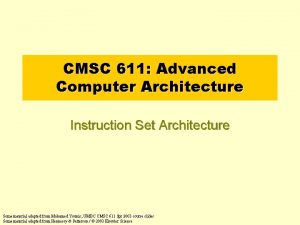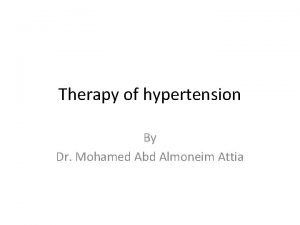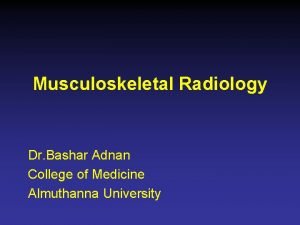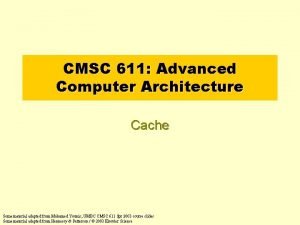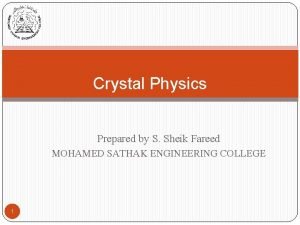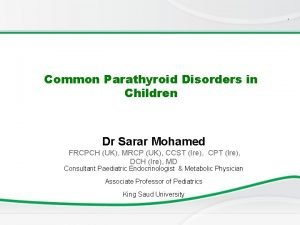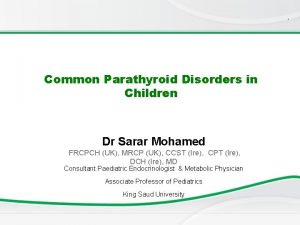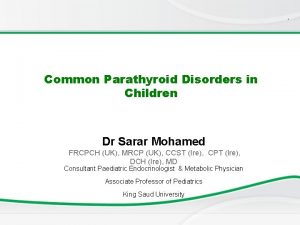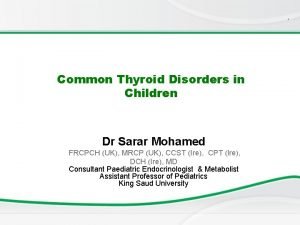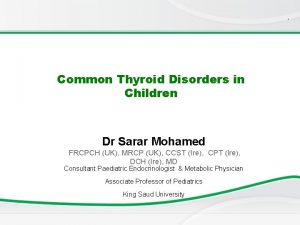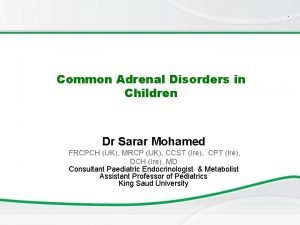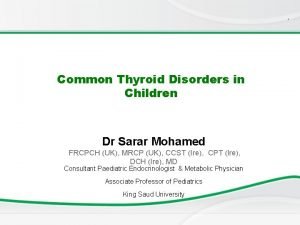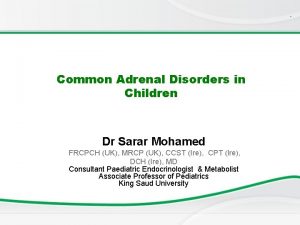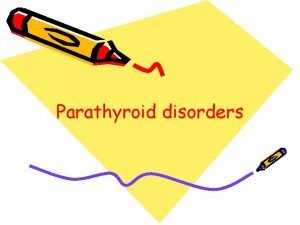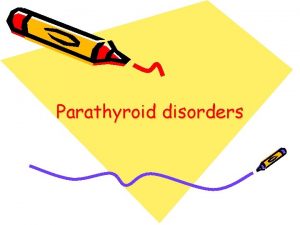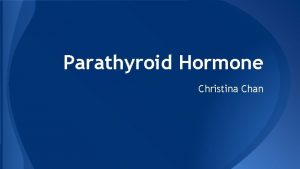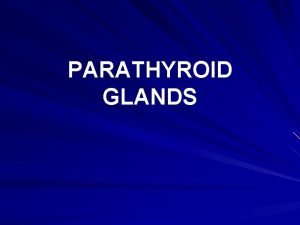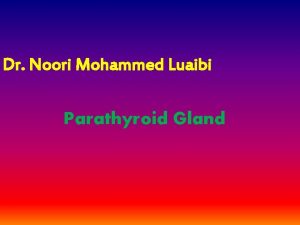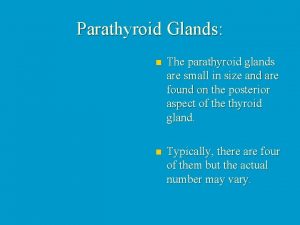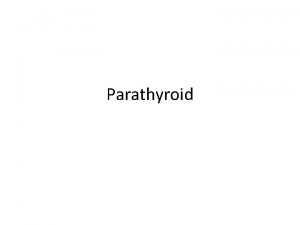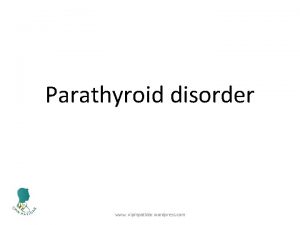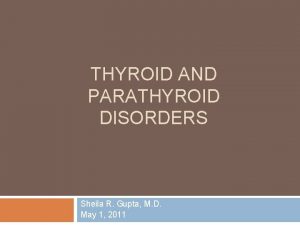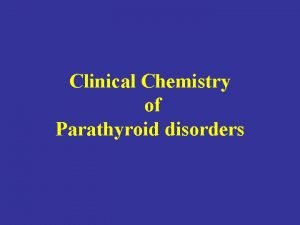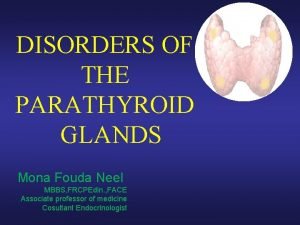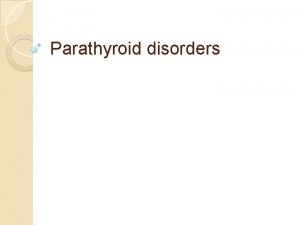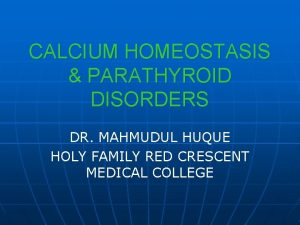Common Parathyroid Disorders in Children Dr Sarar Mohamed








































- Slides: 40

. Common Parathyroid Disorders in Children Dr Sarar Mohamed FRCPCH (UK), MRCP (UK), CCST (Ire), CPT (Ire), DCH (Ire), MD Consultant Paediatric Endocrinologist & Metabolist Assistant Professor of Pediatrics King Saud University

Endocrine Glands

Agenda • Pararthyroid gland Anatomy and physiology • Causes of hypocalcemia • Rickets • hypercalcemia .

PARATHYROID GLAND • Very small (less than 5 mm). • Called parathyroid glands because of their position on posterior margins outer surface of thyroid gland. Development: Like thyroid gland, develop from early pharynx


PARATHYROID GLAND Function: PARATHYROID HORMONE (PTH) – raises the level of calcium in the blood, decreases levels of blood phosphate. Partially antagonistic to calcitonin of thyroid gland.

Dysfunction of parathyroid Gland 1. Too little parathyroid hormone – hypoparahypothyroidism causes low serum calcium and high phosphate 2. Too much parathyroid hormone– hyperparahyperthyroidism causes high calcium and low phosphate

Key-players of calcium metabolism • • • Calcium & Phosphates Parathyroid hormone (PTH). Cholecalciferol and Calcitriol (Vit. D 3). Estrogen and other Sex hormones. Calcitonin.

Key-words • • • Osteoblasts Osteoclast Mineralization Osteoid - Bone forming - Bone absorbing - Calcium, phosphate - Type 1 collagen

Target Organs Kidney G. I. Tract Bone

PARATHYROID HORMONE • Secreation stimulated by fall in serum Ca. • mobilize calcium from bone • Increases renal reabsorption of ca • � decreases renal clearance of calcium • �increase calcium absorption - intestine Calcium homeostasis

Vitamin D • Fat soluble ‘vitamin’ • Synthesised in skin • Food sources include fish oils


Vitamin D The active hormone is 1, 25(OH)2 D 3 It increases absorption of calcium from gut. It increases reabsorption of ca from kidney. .

Calcitonin • It is a calcium lowering hormone • Secreted by Thyroid C cells Anti - PTH

Calcium profile • • To diagnose a metabolic bone disease calcium Phosphate Alkaline phosphatase Parathyroid hormone Vitamin D Urinary calcium and phospherus

Causes of hypocalcemia • • • Rickets Hypopararthyroidism Psuedohypopararthyroidism Familial hypocalcemia Renal failure Drugs: phenytoin Maternal diabetes Premarurity Di. Goerge syndrome .

Deficiency of Vit. D • Dietary lack of the vitamin • Insufficient ultraviolet skin exposure • Malabsorption of fats and fat-soluble vitamins- A, D, E, & K. • Abnormal metabolism of vitamin D chronic renal failure. Rickets

Rickets • Reduced mineralization of bone matrix due to calcium deficiency. Calcium deficiency rickets results when the osteoid does not have mineral.

Rickets: Non renal causes – • • • Nutritional Intestinal – malabsorption Hepatobiliary Metabolic – anticonvulsant therapy Rickets of prematurity

Renal causes • Renal osteodystrophy: CRF Familial hypophosphataemic rickets Renal tubular acidosis Fanconi syndrome Primary Secondary - cystinosis, wilsons disease, lowe syndrome, tyrosinemia Vitamin D dependent type 1 rickets Vitamin D dependent type 2 rickets

Rickets: Effect at growth end plate • Inadequate growth plate mineralization. • Defective calcification in the interstitial regions • The growth plate increases in thickness. • The columns of cartilage cells are disorganized.

Rickets v Cupping of the epiphyses. v Bones incapable of withstanding mechanical stresses and lead to bowing deformities. v Eventual length of the long bones is diminished. ( short stature)

Age of presentation • VITAMIN D DEFICIENCY RICKETS – 6 to 18 months. • NON NUTRITIONAL RICKETS Beyond this age group.

Skeletal manifestations of Rickets • • Craniotaes Delayed closure of anterior fontanelle Frontal and parietal bossing Delayed eruption of primary teeth

Skeletal manifestations EXTREMITIES – Enlargement of long bones around wrists and ankles Bow legs, knock knees green stick fractures

Extra – skeletal manifestations SEIZURES AND TETANY – Secondary to hypocalcemia HYPOTONIA AND DELAYED MOTOR DEVELOPMENT In rickets developing during infancy.





Investigations, • BASIC INVESTIGATIONS TO CONFIRM RICKETS • • Low or normal serum Ca Low phospherus High alkaline phosphatase X rays of ends of long bones at knees or wrists • Shows Widening, fraying, cupping of the distal ends of shaft. • Vit D level low • Parathyroid hormone high

Newborn Screening Rickets • Radiology changes


Genu valgus Wrist cupping Tri radiate pelvis Looser’s zones Wrist widening Wide metaphysis

Vitamin D Resistant Rickets • In the renal tubular disorders, rickets develops in the presence of normal intestinal function and are not cured by normal doses of vitamin D. • Resistant or refractory rickets. Defective final conversion of Vit. D in to active form. End organ insensitivity.

Vitamin D Resistant Rickets

Vitamin D Resistant Rickets

Treatment of Rickets • Vitamin D supplement • Type and dose depens on underline cause of Rickets

Causes of hypercalcemia • Hyperparathyroidism • Vitamin D intoxicity • William syndrome • Familial hypocalcuric hypercalcemia • malignancy .
 Fahri sarar
Fahri sarar Nail disease
Nail disease Hypothalamus
Hypothalamus Parathyroid glands
Parathyroid glands Parathyroid cell
Parathyroid cell Histological structure of parathyroid gland
Histological structure of parathyroid gland Pituitary hormones and their targets
Pituitary hormones and their targets Parathyroid hormone and calcitonin
Parathyroid hormone and calcitonin Parathyroid hormone definition
Parathyroid hormone definition Parathyroid hormone pathway
Parathyroid hormone pathway Vitamin d and pth
Vitamin d and pth Superior thyroid artery is a branch of
Superior thyroid artery is a branch of Thyroid scan
Thyroid scan Pharyngeal arches
Pharyngeal arches True capsule of thyroid gland
True capsule of thyroid gland Abdelrahman mohamed
Abdelrahman mohamed Mohamed salah
Mohamed salah Mohamed seghir nekkache
Mohamed seghir nekkache Riham mohamed aly
Riham mohamed aly Mohamed fayad sjsu
Mohamed fayad sjsu Iszlám padisahja
Iszlám padisahja Chafik el idrissi
Chafik el idrissi Nyu parallel computing
Nyu parallel computing Dr mohamed eldeib
Dr mohamed eldeib Mohamed homayed
Mohamed homayed Mohamed younis umbc
Mohamed younis umbc Mohamed samir design
Mohamed samir design Mohamed akel
Mohamed akel Mohamed akel
Mohamed akel Dr. mohammad diab
Dr. mohammad diab Mohamed dahoui
Mohamed dahoui Abukar mohamed
Abukar mohamed Mohamed hmiden
Mohamed hmiden Mohamed samir design
Mohamed samir design Mohamed taamouti
Mohamed taamouti Dr mohamed bashar shala
Dr mohamed bashar shala Power rating
Power rating Mohamed younis umbc
Mohamed younis umbc Muhammed computer technology
Muhammed computer technology Soumia ecrit en arabe
Soumia ecrit en arabe Point defects in crystals
Point defects in crystals



